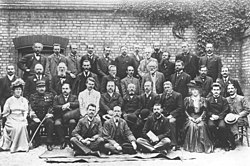L. L. Zamenhof
Ludwik Lejzer Zamenhof (/ˈzæmənhɒf/; Polish: [Ludwik Łazarz Zamenhof] Error: {{Lang}}: text has italic markup (help), Yiddish: לײזער לֵוִי זאַמענהאָף; 15 December [O.S. 3 December] 1859 – 14 April [O.S. 1 April] 1917), credited as L. L. Zamenhof and sometimes as the pseudonymous Dr. Esperanto, was an eye doctor, linguist (who creates a language), and scholar who created the international language Esperanto.
L. L. Zamenhof | |
|---|---|
 Zamenhof, c. 1895 | |
| Born | Leyzer Zamengov 15 December 1859 |
| Died | 14 April 1917 (aged 57) |
| Burial place | Jewish Cemetery, Warsaw 52°14′51″N 20°58′29″E / 52.24750°N 20.97472°ECoordinates: 52°14′51″N 20°58′29″E / 52.24750°N 20.97472°E |
| Occupation | Ophthalmologist |
| Known for | Esperanto |
| Spouse(s) | |
| Children | Adam, Zofia, and Lidia |
| Awards | |
| Writing career | |
| Pen name | Dr. Esperanto |
| Notable works |
|
| Signature | |
Biography
Zamenhof was born in 1859 in the town of Białystok, Poland. At the time, Poland was a part of the Russian Empire. Bialystok contained three major groups: Poles, Belorussians, and Yiddish-speaking Jews. Zamenhof thought that one common language would join these groups and stop fights between them.
His first language was said to be Polish. His parents spoke Russian and Yiddish at home. His father was a German teacher, so Zamenhof learned that language from an early age and spoke the language fluently. Later he learned French, Latin, Greek, Hebrew and English. He also had an interest in Italian, Spanish and Lithuanian.
Zamenhof decided that the international language must have a simple grammar and be easier to learn than Volapük, an earlier international language. He attempted to create the international language with a grammar that was rich, and complex. The basics of Esperanto were published in 1887. He translated the Hebrew Bible into Esperanto.
His grandson, Louis-Christophe Zaleski-Zamenhof, was an engineer.
He was 14 times nominated for the Nobel Peace Prize between 1907 and 1917.[1]
Partial bibliography
Original works
- Unua Libro, 1887 (First Book)
- Dua Libro, 1888 (Second Book)
- Hilelismo – propono pri solvo de la hebrea demando Archived 20 March 2019 at the Wayback Machine, 1901 (Hillelism: A Project in Response to the Jewish Question)
- Esenco kaj estonteco de la ideo de lingvo internacia Archived 13 April 2018 at the Wayback Machine, 1903 (Essence and Future of the Idea of an International Language)
- Fundamenta Krestomatio de la Lingvo Esperanto Archived 4 March 2020 at the Wayback Machine, 1903 (Basic Anthology of the Esperanto Language)
- Fundamento de Esperanto, 1905 (Foundation of Esperanto)
- Declaration of Boulogne, 1905
- Homaranismo Archived 5 May 2021 at the Wayback Machine, 1913 (Humanitism)
Periodicals
- La Esperantisto, 1889–1895 (The Esperantist)
- Lingvo Internacia, 1895–1914 (International Language)
- La Revuo, 1906–1914 (The Review)
Poems
- "Al la fratoj" ("To the Brothers")[2]
- "Ho, mia kor'" ("Oh, My Heart")
- "La Espero" ("The Hope")
- "La vojo" ("The Way")[3]
- "Mia penso" ("My Thought")[4]
Translations
- Hamleto, Reĝido de Danujo Archived 29 April 2021 at the Wayback Machine, 1894 (Hamlet, Prince of Denmark, by William Shakespeare)
- La batalo de l' vivo Archived 25 September 2020 at the Wayback Machine (The Battle of Life, by Charles Dickens)
- La revizoro, 1907 (The Government Inspector, by Nikolai Gogol)
- La Predikanto, 1907 (translation of Ecclesiastes)
- La Psalmaro, 1908 (translation of the book of Psalms)
- La rabistoj Archived 22 February 2020 at the Wayback Machine, 1908 (The Robbers, by Friedrich Schiller)
- Ifigenio en Taŭrido Archived 29 April 2021 at the Wayback Machine, 1908 (Iphigenia in Tauris, by Johann Wolfgang von Goethe)
- La Rabeno de Baĥaraĥ, 1909 ("The Rabbi of Bacharach", by Heinrich Heine)
- La Gimnazio, 1909 ("The High School", by Scholem Aleichem)
- Marta Archived 14 December 2019 at the Wayback Machine, 1910 (Marta, by Eliza Orzeszkowa)
- Genezo, 1911 (translation of the Book of Genesis)
- Eliro, 1912 (translation of the Book of Exodus)
- Levidoj, 1912 (translation of the Book of Leviticus)
- Nombroj, 1914 (translation of the Book of Numbers)
- Readmono, 1914 (translation of the Book of Deuteronomy)
- Malnova Testamento (parts of the Old Testament)
L. L. Zamenhof Media
Families Zamenhof and Alfred Michaux at the first Esperanto Congress, Boulogne 1905
Zamenhof at his desk in his Warsaw apartment, 1910
The Esperanto Lingva Komitato (Language Committee) in 1907. Zamenhof is seated in the centre of Esperantists including Louisa Frederica Adela Schafer, Louis de Beaufront and Rosa Junck.
Zamenhof speaking at the World Esperanto Congress in Barcelona (Spain) in 1909
Grave of Ludwik Zamenhof, designed by Mieczysław Lubelski and made of Aberdeen granite, Jewish Cemetery, Warsaw 2017
Plaque in Rue du Vieux-Collège, commemorating Zamenhof's residence in Geneva, Switzerland in 1905
Zamenhof Street, Tel Aviv
References
- ↑ "Nomination Database". Nobelprize.org. Nobel Media AB. 2014. Retrieved 2018-01-13.
- ↑ Privat, Edmond (1920). "Idealista profeto". Vivo de Zamenhof (in Esperanto). Archived from the original on 19 October 2020. Retrieved 12 April 2018.
- ↑ Privat, Edmond (1920). "Verkisto". Vivo de Zamenhof (in Esperanto). Archived from the original on 19 October 2020. Retrieved 12 April 2018.
- ↑ Privat, Edmond (1920). "Studentaj jaroj". Vivo de Zamenhof (in Esperanto). Archived from the original on 19 October 2020. Retrieved 12 April 2018.








